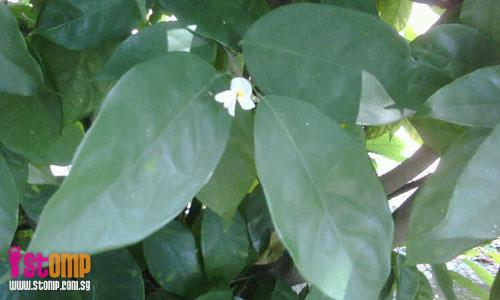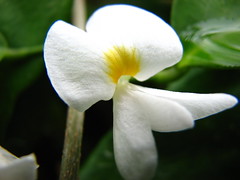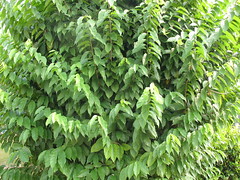
Because this plant by the side of the road on Ang Mo Kio Avenue 10 usually bears no flowers, STOMPer Jeffrey and his colleagues were surprised when they saw small white flowers on it.
Jeffrey, who has been working in the vicinity for the past 18 years, says that the plant has always been there but has never born flowers before.
He wonders if this is a auspicious sign and says:
"I saw this flower on some bushes.
"Is it normal?
"Anyway, spring is coming.
"I hope this is a sign of better prospects for Singapore's future economically."
Related story:
Native African plant is not flowerless, says STOMPer
Update: Native African plant is not flowerless, says STOMPer
I recognise the plant in question. It's very commonly planted all over Singapore, especially along wire fences. I'm not a botanist, so it took me quite some time before I could positively identify this species. Fortunately, I managed to find a copy of Wee Yeow Chin's Tropical Trees and Shrubs: A Selection for Urban Planting.
This plant is known as camwood or African sandalwood (Baphia nitida). A native of western Africa, it is a leguminous tree that can grow to about 5 metres in height. However, here in Singapore, it is pruned regularly to form hedges and living fences.

Here it is shown growing as a tree.

And here it is shown growing as a hedge.
Here's a closer look at the flowers and leaves.


(Photos by woanyeen)
Traditionally, a reddish dye was extracted from the wood, and was used to dye textiles and as paint. The wood is used to make various objects such as violin bows, umbrella handles and walking sticks, while the leaves are often used as fodder.
The person who submitted this post probably needs to be a bit more observant, since I have in fact observed flowers on this plant quite frequently. The flowers are quite small, so it is probably easy to miss them.
Interestingly enough, the book says that this plant has not been observed to fruit in Singapore, although it is easily propagated by seeds and cuttings. Leguminous plants are commonly pollinated by bees, and it is likely that the west African bee species which usually pollinates this plant in its native range is absent in Singapore. However, even so, it is surprising that our native bees are not an effective substitute for this missing pollinator. If this is the case, then camwood flowers in Singapore are not being fertilised in the first place, hence explaining the lack of fruits.